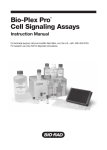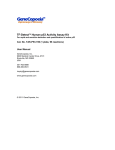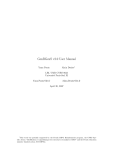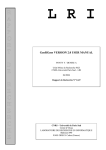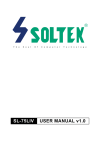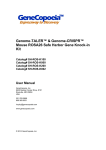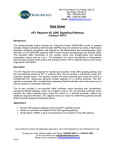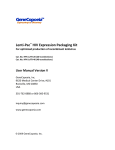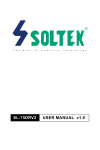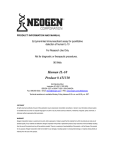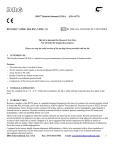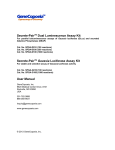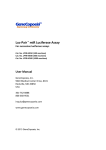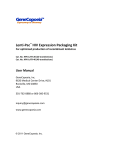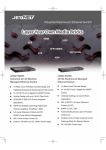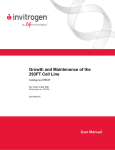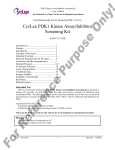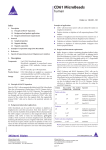Download • Preparation of Lentiviral expression construct DNA:
Transcript
G eneCopoeia Expressway to Discovery TM TF-DetectTM AP-1/c-Jun Activity Assay Kit For rapid and sensitive detection of active c-Jun in human, mouse or rat samples Cat. No. TAK-JUN-196 (1 plate, 96 reactions) User Manual GeneCopoeia, Inc. 9620 Medical Center Drive, #101 Rockville, MD 20850 USA 301-762-0888 866-360-9531 [email protected] www.genecopoeia.com © 2011 GeneCopoeia, Inc. TF-DetectTM AP-1/c-Jun Activity Assay Kit User Manual USER MANUAL TF-DetectTM AP-1/c-Jun Activity Assay Kit I. II. III. IV. V. VI. Introduction and Principle Kit Components and Storage Preparation of Reagents Procedure Appendix Limited Use License and Warranty I. Introduction and Principle c-Jun, together with Fos and other Jun-related proteins, forms a homodimeric or heterodimeric transcription factor complex AP-1. AP-1 binds to a TPA DNA Response Element (TRE), the heptamer enhancer motif 5’TGA[C/G]TCA-3’, and regulates gene expression in response to a variety of stimuli including growth factors, tumor promoters, and cytokines. AP-1 controls cellular processes including differentiation, proliferation, apoptosis and stress response. c-Jun is tightly regulated post-translationally through phosphorylation. It has several phosphorylation sites. The C-terminal one is near the DNA binding domain of c-Jun and its phosphorylation represses c-Jun activity during the resting condition. The other two phosphorylation sites, Ser63 and Ser73, are near the transactivation domain of c-Jun. SAPK/JNKs activate c-Jun by phosphorylating Ser63 and Ser73. TF-DetectTM AP-1/c-Jun Activity Assay kit enables fast and sensitive detection of Ser73phosphorylated c-Jun in human, mouse or rat samples in a 96-well format. Double-stranded oligonucleotides containing the AP-1/c-Jun consensus binding site are immobilized in the 96well plate. The c-Jun proteins present in nuclear extracts are captured by the immobilized oligonucleotides specifically. The Ser73-phosphorylated c-Jun is detected by a phosphor-cJun antibody and a HRP-conjugated secondary antibody. The colorimetric signal generated by HRP substrate TMB can be easily quantified by spectrophotometry. The Ser73 phospho-cJun antibody that detects Ser73-phosphorylated c-Jun also recognizes Ser100phosphorylated JunD, as this site is conserved between c-Jun and JunD. Protocol overview Rinse 96-well plate (coated with AP-1/c-Jun binding oligonucleotides) Bind c-Jun (in nuclear extract) to the immobilized oligonucleotides 1 hour Wash 3X. Add c-Jun antibody 1 hour Wash 3X. Add HRP-conjugated IgG antibody 1 hour Wash 3X. Colorimetric reaction ------------------------------------Total ~3.5 hours 2 TF-DetectTM AP-1/c-Jun Activity Assay Kit User Manual Key advantages Multiple species – Detects human, mouse or rat activated c-Jun. HTS compatible - Optimized for use with 96-well plate readers for high-throughput screening assays. Single strip (8-well) assay can also be performed. Fast - 3.5 hours from preparation to detection. Sensitive – Detect Ser73-phosphorylated c-Jun in as low as 0.2 μg of nuclear lysate (Figure 1). 4 NIH3T3 cells (Mouse) MCF-7 cells (Human) 1.5 2 A450 A450 3 1 1 0.5 0 0 0 0 0.5 1 1.5 2 2.5 3 3.5 4 4.5 5 Nuclear Lysate (ug) 10 20 Nuclear Lysate (ug) 30 Figure 1. The activities of c-Jun proteins in the nuclear extracts of MCF-7 (left) and NIH3T3 (right) cells were detected using the TF-Detect AP-1/c-Jun Activity Assay Kit. Both cell types were treated with UV light for 20 Sec before harvesting. The cellular nuclear extracts were prepared following the Preparation of Nuclear Extract protocol in the Appendix. II. Kit Components and Storage Cat. No. TAK-JUN-196 (1 plate, 96 reactions) Components Quantity Storage temperature c-Jun Antibody 15 µl -20°C Stable for at least 6 months HRP-Conjugated IgG 15 µl -20°C Stable for at least 6 months MCF-7 Nuclear Lysates (Positive Control) 25 µl -20°C Stable for at least 6 months Dithiothreitol (DTT) (1M) 100 µl -20°C Stable for at least 6 months 10x Binding Buffer A 1.5 ml -20°C Stable for at least 6 months 10x Binding Buffer B 1.5 ml x 2 -20°C Stable for at least 6 months 10x Wash Buffer 25 ml 4°C Stable for at least 6 months TMB Substrate Solution 12 ml 4°C Stable for at least 6 months Stop Solution 12 ml 4°C Stable for at least 6 months 96-Well AP-1 Assay Plate (12 Strips) 1 plate 4°C Stable for at least 6 months 3 TF-DetectTM AP-1/c-Jun Activity Assay Kit User Manual Materials required but not provided 5 ml and 10 ml graduated pipettes, beakers, flasks, and cylinders 10 μl to 1,000 μl adjustable single channel micropipettes with disposable tips 50 μl to 300 μl adjustable multichannel micropipette, disposable tips, and reservoir Micro-plate reader capable of reading at 450 nm (620 nm as optional reference wave length) III. Preparation of Reagents Prepare a little bit extra than required amount to make sure enough buffers are available for experiments. Required amount of reagents per well: Reagent 1 well Nuclear extract sample 10 µl MCF-7 nuclear lysate (positive control) 2 µl 1x binding buffer A (with DTT at 2 mM) 50 µl 1x wash buffer 2 ml c-Jun antibody in 1x binding buffer B (1:1000) 100 µl HRP IgG antibody in 1x binding buffer B (1:1000) 100 µl TMB substrate 100 µl Stop solution 100 µl Nuclear extract samples We recommend using 10 µl of nuclear extract at 0.2 - 5 µg/µl for each sample well. The total protein amount is 2-50 µg per well. Note: The recommended amount is provided as guidance. A broader range of value may be used. C-Jun positive control 2 µl of the MCF-7 Nuclear Lysate can be used as the positive control. Binding buffer A and B Warm up 10x Binding Buffer A and B to room temperature and mix well before use. To prepare 100 ml of 1x Binding Buffer, add 10 ml of the 10x buffer to 90 ml distilled or deionized water. Mix gently to avoid foaming. The 1x Binding Buffers are stable for 30 days at 4°C. Add 200 μl of 1M DTT to 100 ml of 1x Binding Buffer A before use (2mM DTT – final concentration). Wash buffer Warm up 10x Wash Buffer to room temperature and mix well before use. If crystals have formed in the 10x buffer, warm and mix gently until they have completely dissolved. To prepare 200 ml of 1x Wash Buffer for one 96-well plate assay, add 20 ml of the 10x Wash Buffer into 180 ml distilled or deionized water. Mix gently to avoid foaming. The 1x Wash Buffer is stable for 30 days at 4°C. It can be stored at -20°C for longer time. Primary c-Jun antibody Calculate the amount of primary c-Jun antibody needed to perform the desired experiments and make 1:1000 dilutions with 1x Binding Buffer B (100 μl/well). 4 TF-DetectTM AP-1/c-Jun Activity Assay Kit User Manual Secondary HRP conjugated antibody Calculate the amount of HRP conjugated antibody needed to perform the desired experiments and make 1:1000 dilution with 1x Binding Buffer B (100 μl/well). TMB substrate solution Take appropriate volume of TMB Substrate (100 μl/well) and warm it up to room temperature 1 hour before use. Note: Avoid direct exposure of TMB reagents to intense light and oxidizing agents during storage or incubation. The TMB Substrate Solution may develop a yellow tinge over time. This does not affect the product performance. A blue color in the TMB Substrate Solution, however, indicates that it has been contaminated and must be discarded. After use, discard remaining TMB substrate solution. Stop solution Prior to use, take appropriate volume of Stop Solution (100 μl/well) and warm it up to room temperature before use. After use, discard remaining Stop Solution. IV. Procedure Determine the number of wells and strips needed. Store the unused strips at 4°C. 1. Mix all reagents thoroughly yet gently to avoid foaming before use. 2. Rinse the 96-well plate with approximately 200 μl Wash Buffer per well. Empty and tap the plate on absorbent pad or paper towel to remove excess buffer. Be careful not to scratch the surface of the 96-well plate. Note: Use the plate immediately after washing or place upside down on a wet absorbent paper for not longer than 15 minutes. 3. Add c-Jun samples to the wells as following: Nuclear extract wells: Add 50 µl of Binding Buffer A (with 2mM DTT) to the wells, and then add 10 µl samples (2-50 µg of proteins). Mix well. Duplicated wells for each sample are recommended. Positive control wells Add 58 µl of Binding Buffer A (with 2mM DTT) to the wells, and then add 2 µl of MCF-7 Nuclear Lysate per well. Mix well. Blank wells: Add 60 µl of Binding Buffer A (with 2mM DTT). 4. Cover the plate with a plate cover. Incubate at room temperature for 1 hour by gently rocking the plate. 5. Remove the plate cover and empty the wells. Wash the plate using 200μl/well of 1X Wash Buffer by gently rocking it for one minute, and then empty and tap the plate on absorbent pad or paper towel to remove excess buffer. Repeat the wash step twice. 6. Add 100 μl of 1:1000 diluted c-Jun primary antibody in 1X Binding Buffer B to each well, including the blank wells. Cover the plate with a plate cover. Incubate at room temperature for 1 hour by gently rocking the plate. 7. Remove the plate cover and empty the wells. Wash the plate with 200 μl/well of 1X Wash Buffer by gently rocking it for one minute. Then empty and tap the plate on absorbent pad or paper towel to remove excess buffer. Repeat the wash step twice. 8. Add 100 μl of 1:1000 diluted HRP conjugated antibody in 1X Binding Buffer B to each well, including the blank wells. Cover the plate with a plate cover. Incubate at room temperature for 1 hour by gently rocking the plate. 5 TF-DetectTM AP-1/c-Jun Activity Assay Kit User Manual 9. Remove the plate cover and empty the wells. Wash the plate with 200 μl/well of 1X Wash Buffer by gently rocking it for one minute. Then empty and tap the plate on absorbent pad or paper towel to remove excess buffer. Repeat the wash step twice. 10. Add 100 μl of TMB Substrate Solution (equilibrated to room temperature) to each well (including the blank wells) and mix well. Incubate the plate at room temperature for about 515 minutes. 11. Add 100 μl Stop Solution (equilibrated to room temperature) to each well (including the blank wells) and mix well. Read the plate at 450nm within 5 minutes using a microwell plate reader. V. Appendix Preparation of Nuclear Extract 1. Aspirate medium from a 10 cm plate and wash the cells with ice-cold PBS. 6 2. Add 1 ml of ice-cold PBS (per 10 cm plate, 4 - 8 x 10 cells). Scrape the cells into PBS and then transfer them into a pre-chilled eppendorf tube. 3. Spin at 4ºC, 2,000 rpm for 5 minutes. Discard the supernatant. 4. Resuspend the cell pellet in 200 µl of Buffer 1 (per 10cm plate, scale up or down proportionally for other size culture vessels). Incubate on ice for 15 minutes to allow cells to swell. 5. Add 20 µl of Buffer 2 to the cells. Vortex for 10 seconds. Then incubate on ice for 5 minutes. 6. Spin at 4ºC, 14,000 rpm for 3 minutes. 7. Transfer the supernatant (cytoplasmic proteins) into a new eppendorf tube. 8. Add another 200 µl of Buffer 1 to the cell pellet and mix gently. 9. Spin at 4ºC, 14,000 rpm for 3 minutes. 10. Transfer and combine the supernatant in the cytoplasmic protein tube from step 7. 11. Resuspend the pellet with 200 µl of ice-cold Buffer 3. Vortex for 30 seconds. (Optional: Sonicate for 2-3 seconds to break down the pellet.) Then rotate vigorously at 4ºC for 30 minutes. 12. Spin at 4ºC, 14,000 rpm for 10 minutes. 13. Transfer the supernatant (nuclear proteins) into a fresh, pre-chilled tube. Measure the protein concentrations. Leave on ice if use immediately, or store aliquots at -80ºC until use. Buffer 1: 25 mM HEPES, pH 7.4 10 mM KCl 1.5 mM MgCl2 1 mM DTT 10 mM PMSF Buffer 2: 10% IGEPAL (Igepal CA-630, Sigma) Buffer 3: 25 mM HEPES, pH 7.4 420 mM NaCl 25% Glycerol 1.5 mM MgCl2 0.2 mM EDTA 1 mM PMSF 6 TF-DetectTM AP-1/c-Jun Activity Assay Kit User Manual VI. Limited Use License and Warranty Limited Use License Following terms and conditions apply to use of TF-Detect AP-1/c-Jun Activity Assay Kit (the Product). If the terms and conditions are not acceptable, the Product in its entirety must be returned to GeneCopoeia within 5 calendar days. A limited End-User license is granted to the purchaser of the Product. The Product shall be used by the purchaser for internal research purposes only. The Product is expressly not designed, intended, or warranted for use in humans or for therapeutic or diagnostic use. The Product must not be resold, repackaged or modified for resale, or used to manufacture commercial products or deliver information obtained in service without prior written consent from GeneCopoeia. This Product should be used in accordance with the NIH guidelines developed for recombinant DNA and genetic research. Use of any part of the Product constitutes acceptance of the above terms. Limited Warranty GeneCopoeia warrants that the Product meets the specifications described in the accompanying Product Datasheet. If it is proven to the satisfaction of GeneCopoeia that the Product fails to meet these specifications, GeneCopoeia will replace the Product. In the event a replacement cannot be provided, GeneCopoeia will provide the purchaser with a refund. This limited warranty shall not extend to anyone other than the original purchaser of the Product. Notice of nonconforming products must be made to GeneCopoeia within 30 days of receipt of the Product. GeneCopoeia’s liability is expressly limited to replacement of Product or a refund limited to the actual purchase price. GeneCopoeia’s liability does not extend to any damages arising from use or improper use of the Product, or losses associated with the use of additional materials or reagents. This limited warranty is the sole and exclusive warranty. GeneCopoeia does not provide any other warranties of any kind, expressed or implied, including the merchantability or fitness of the Product for a particular purpose. GeneCopoeia is committed to providing our customers with high-quality products. If you should have any questions or concerns about any GeneCopoeia products, please contact us at 301-762-0888. GeneCopoeia Products are for Research Use Only Trademarks: GeneCopoeia™, TF-Detect™ (GeneCopoeia Inc.) Copyright © 2011 GeneCopoeia, Inc. TAKJUN081611 7







